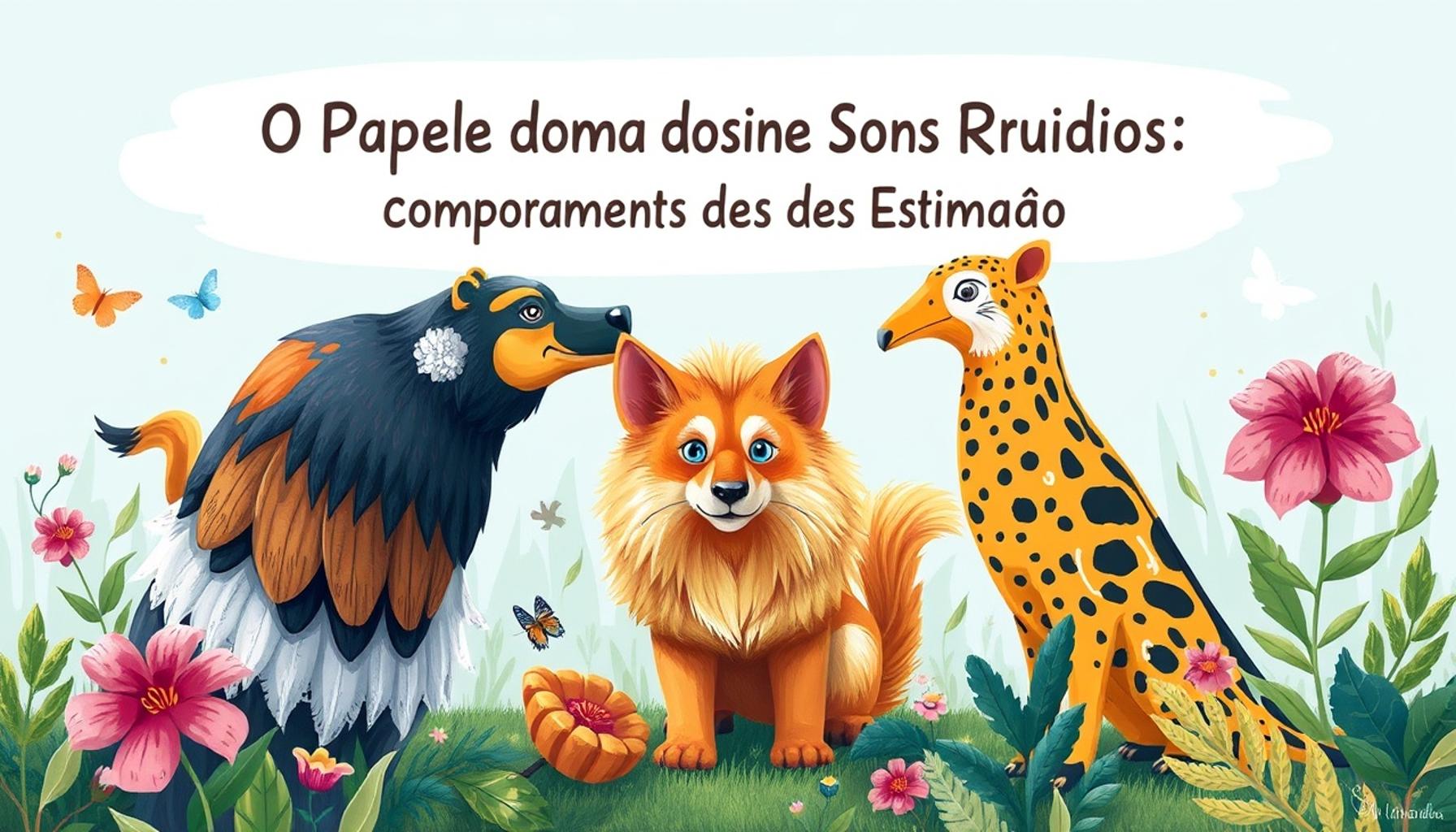The Role of Sounds and Noises in Pet Behavior

Understanding the Impact of Sounds on Pets
The auditory world our pets navigate is rich and complex. Sounds and noises significantly impact behavior, mood, and even the physical health of our animal companions. For instance, the gentle rustle of leaves can evoke curiosity, while the sharp clang of pots may signal stress. By recognizing these audio cues, pet owners can foster a deeper connection with their beloved companions and tailor environments that promote well-being.
Key Aspects of Sounds in Pet Behavior
Understanding how pets react to various sounds is essential for their owners. Here are several vital factors to consider:
- Communication: Animals possess a distinct language of sounds. For example, barking, meowing, or purring serve as emotional expressions. A dog might bark vigorously when excited, whereas a cat may purr when content. In Nigeria, where many households have dogs or cats, recognizing these sounds can help owners respond appropriately—whether it’s giving attention to a pleading pet or respecting their space when they display stress.
- Fear Responses: Many pets exhibit fear reactions to sudden, loud noises. Common occurrences like thunder or fireworks can prompt anxiety in dogs and cats alike. In urban Nigerian environments, where celebrations often include fireworks, understanding this reaction can be pivotal. Pet owners should consider strategies to create safe spaces for their pets during these events, such as using noise-cancellation tools or providing a cozy hideaway.
- Training Cues: Consistency is key in the pet training process. Utilizing consistent sounds, such as clickers or specific verbal commands, enables effective reinforcement of desired behaviors. In many Nigerian communities, this method can be seen in action at local training sessions, where harmony between owner and pet is cultivated through sound-based cues.
- Environmental Awareness: Pets are keenly tuned to their surroundings, often responding to sounds that indicate changes. For example, the sound of a vehicle pulling up might alert a dog to the presence of a visitor, while the scattering of birds could signal a potential prey to a cat. This heightened sense of hearing underscores the importance of understanding what your pets might be perceiving from their environment.
In Nigeria, recognizing these dynamics can greatly enhance our relationship with pets, helping ensure their safety and emotional well-being. By observing their responses to different sounds, owners can craft environments conducive to pet comfort and happiness, decreasing anxiety triggers and fostering positive behaviors.
The Journey Ahead
Diving deeper into the intricate relationship between sounds and pet behavior reveals the multifaceted nature of animal emotions and responses. This exploration arms pet owners with invaluable insights that can improve the quality of life for both parties. As you delve into how sound shapes your pet’s world, be prepared to discover tools and techniques that will help nurture your pet’s environment in a way that respects their instincts and feelings. Get ready to engage with your furry friends on a deeper level and to make sound an ally in enhancing their lives.
YOU MAY ALSO LIKE: Read read another article

The Influence of Specific Sounds on Animal Responses
Pet behavior is often a mirror reflecting the intricate dynamics of their environment, particularly through sounds. Understanding how specific noises affect pets is not only vital for their welfare, but it can significantly enhance the harmony of the human-animal relationship. In Nigeria, where diverse sounds permeate everyday life, from market chatter to the celebratory sounds of festivals, pet owners must navigate a rich auditory landscape to understand their pets’ reactions effectively.
Common Sounds and Their Behavioral Impacts
Different sounds provoke distinct reactions in pets. Here are some typical sounds and their associated impacts on behavior:
- Household Noises: The everyday clattering of dishes or the whirring of a fan can elicit curiosity or anxiety in pets. Many dogs may bark at the sound of walking household members, while cats might scurry for cover when confronted with unknown noises. Recognizing these reactions can prompt owners to create a calmer home environment.
- Environmental Sounds: Outside noises, such as the honking of cars or the chatter of people, can cause pets to become alert or agitated. In densely populated areas of Nigeria, these stimuli may overwhelm sensitive pets. Owners should observe their pets for signs of stress and consider strategies, such as gradual desensitization to common noises or providing soothing background sounds, to alleviate anxiety.
- Natural Sounds: Exposure to nature sounds like birds singing or the rustle of grass can have a calming effect on pets. These are noises that stimulate their natural instincts and can lead to an enhanced sense of exploration. For example, a cat hearing birds outside may exhibit stalking behavior, while a dog could become more playful and invigorated.
- Human Communication: The voice of an owner can serve as a powerful tool in shaping pet behavior. Pets often respond positively to their owner’s tone, with cheerful voices eliciting excitement and affection, while stern commands convey a sense of seriousness. This is particularly important in a country like Nigeria where interaction with pets is deeply cultural, emphasizing the importance of emotional connection through sound.
The auditory environment can significantly shape pet behavior and their emotional state. By becoming attuned to the sounds that affect their pets, owners can help mitigate stressors and enhance positive behaviors. Creating an audio-friendly living space can lead to happier pets, reducing feelings of anxiety and improving the overall quality of life for both pets and their owners.
Understanding Pet Responses Through Sound
Continually observing how pets react to their auditory surroundings opens a window into their thoughts and feelings. Addressing these sound-related behaviors not only cultivates an environment that respects their needs but also paves the way for a more profound bond between owner and pet. As we tailor our homes to create a comforting auditory atmosphere, we take a pivotal step in enhancing the daily lives of our animal companions. Engaging with their unique responses to sound can reveal a deeper understanding of their behavior and emotional well-being.
| Sound Influences | Behavioral Reactions |
|---|---|
| Environmental Sounds | Animals often react to ambient noises, which can affect their stress levels. |
| Social Communication | Different sounds can signify emotions or intentions, guiding social interactions. |
| Training Responses | Using specific sounds during training can enhance learning abilities. |
| Sound Therapy | Soothing sounds can help alleviate anxiety in pets during stressful situations. |
Exploring how various sounds and noises influence pet behavior unveils profound insights into pet psychology. Whether it’s the sound of nature or familiar voices, these auditory elements play a crucial role in shaping how animals perceive their environment. For instance, environmental sounds can heighten stress or induce calmness, depending on the pet’s previous experiences. In a social setting, pets utilize sounds to communicate their needs and emotions, creating a complex language that requires attentiveness from their owners.Moreover, integrating auditory signals into training sessions has been shown to improve pets’ ability to learn commands, effectively bridging the communication gap between humans and their animal companions. Additionally, the rise of sound therapy has further expanded our understanding of how specific sound frequencies can be harnessed to soothe anxious pets, emphasizing the need for owners to consider the auditory environment they provide for their furry friends. Through examining these aspects, pet owners can better cater to their pets’ emotional and psychological needs.
YOU MAY ALSO LIKE: Read read another article
The Therapeutic Potential of Sounds in Pet Care
Understanding the role of sounds and noises in pet behavior extends beyond mere observation—it opens the door to therapeutic possibilities that can significantly improve the quality of life for pets. In a bustling environment like Nigeria, where noise can often overwhelm, implementing strategic sound therapies can provide relief for pets suffering from anxiety and stress-related behaviors.
Sound Therapy Techniques for Pets
One approach gaining popularity among pet owners is sound therapy, which employs soothing auditory cues to encourage relaxation in animals. Various techniques have been noted to yield positive results:
- Calming Music: Research has shown that specific genres of music, such as classical or soft instrumental tunes, can help calm anxious pets. In environments with frenetic activity, playing gentle melodies may alleviate symptoms of distress in dogs and cats. In Nigeria, many pet owners are now integrating local traditional music infused with soft rhythms to create a familiar and comforting atmosphere for their furry companions.
- White Noise Machines: The continuous sound of white noise can mask jarring household and environmental noises that may trigger anxiety in pets. Devices emitting white noise can be particularly beneficial during events with heavy festivities, such as public celebrations or regional festivals, where loud sounds can overwhelm animals. Pet owners who introduce these machines find it easier to help their pets cope with the ensuing chaos.
- Nature Sound Recordings: Sounds from nature, such as gentle rainfalls, rustling leaves, or distant ocean waves can create an idyllic acoustic space for pets. Many pet owners in Nigeria have begun utilizing recordings of local wildlife sounds, such as the calls of birds or the sounds of flowing rivers, to provide a calming backdrop for their pets. This approach not only enriches the auditory environment but also invokes a sense of harmony with nature, which is essential for the mental well-being of animals.
- Sound Exposure Training: Slowly exposing pets to unfamiliar sounds through training can help desensitize them to loud or startling noises. This is particularly crucial in urban areas where sudden car horns or construction noises can be alarming. Positive reinforcement during these sessions helps pets associate sounds with rewards, leading to a more confident disposition in future encounters.
The application of sound therapy in pet care is gaining momentum, reflecting a deeper understanding of how sounds affect animal physiology and psychology. As pet owners in Nigeria become increasingly aware of these techniques, they build enriching environments that promote calmness and comfort, thereby enhancing the overall well-being of their pets.
The Importance of Consistent Sound Environments
Establishing a consistent sound environment is crucial in shaping pet behavior. Each pet has its unique sound preferences and tolerances; therefore, understanding these needs can help tailor the auditory space at home. Observations indicate that pets thrive when their environments remain stable; for example, maintaining a consistent volume level during routine activities alleviates stress. Animal behaviorists suggest that owners should actively engage with their pets’ auditory stimuli, ensuring that not only positive sounds are incorporated but also minimizing sudden loud noises that can disrupt their peace.
Furthermore, owners should consider the implications of their own noise levels in the home. For example, yelling or loud conversations can elicit fear in pets, while calm and soft communication fosters a sense of security. In a country like Nigeria, where communal living often results in a symphony of sounds, being mindful of how personal noise habits interact with pets can foster a calmer living space.
By paying closer attention to the role of sounds and noises in pet behavior, owners can implement strategies that significantly improve the emotional well-being of their pets. This awareness drives a healthier pet-owner relationship and nurtures an environment where both can thrive together.
SEE ALSO: Click here to read another article
Conclusion: Elevating Pet Welfare through Sound Awareness
In an increasingly noisy world, understanding the role of sounds and noises in pet behavior is essential for nurturing the emotional and psychological well-being of our furry companions. Through a comprehensive exploration of sound therapy techniques, pet owners in Nigeria and beyond can unlock a treasure trove of strategies to create harmonious environments for their pets. From incorporating calming music to using white noise machines, each method offers unique benefits that help alleviate stress and anxiety, connecting our pets to a more centered state of being.
The insights provided in this article emphasize the need for a consistent and tailored auditory environment, reflecting individual sound preferences and tolerances among pets. Whether engaging in sound exposure training or simply being mindful of our own noise levels, the collective effort to create a peaceful atmosphere can forge a deeper bond between pet owners and their animals. By integrating these practical strategies, pet owners can mitigate negative behaviors triggered by excessive noise and foster a space where pets feel safe and secure.
Ultimately, recognizing the intricate relationship between sounds and pet behavior is not merely a point of interest for animal lovers; it is a pivotal step toward enhancing the quality of life for countless animals. As awareness grows and innovative sound therapy practices take root, it becomes clear that a more serene environment can significantly enrich the lives of both pets and their companions. We encourage you to explore these techniques further, ensuring a brighter, calmer future together.


